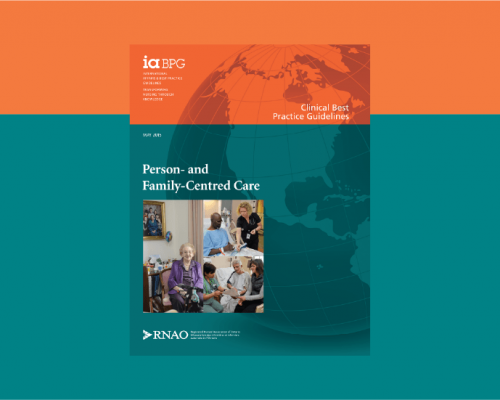
By: Beverly Faubert, RN, BScN, GNC(C), CHPCN(C), CPMHN(C), LTC best practice co-ordinator
How did staff at Watford Quality Care Centre (WQCC) successfully implement RNAO's Person- and Family-Centred Care (PFCC) best practice guideline (BPG) during a pandemic? WQCC is a small Long-Term Care Best Practice Spotlight Organization (LTC-BPSO) pre-designate home in the rural township in Lambton County, Ontario.
The PFCC BPG implementation process was led by Kelly Couwenberg, a personal support worker (PSW) with 29 years of experience at Watford. PSWs are not often selected to lead BPG projects, however they spend the majority of their time with residents, witnessing resident-centred communication and practices. In early 2020, the Watford team, with the support of the RNAO best practice co-ordinator, completed a PFCC BPG gap analysis to better understand areas needing improvement, and established an action plan. The pandemic presented the sudden reality of the enhanced needs of residents.
Kelly promoted a whole home approach. To raise awareness during the pandemic, pen and paper processes supported building capacity. A daily report and tip sheet became a working communication tool for PSWs. Each resident had an index card listing their likes, dislikes, details of diet, toileting routines, bath days, preferred oral care and any significant changes in medical status. This resulted in improved consistency in individualized care. The report sheet was updated daily by the nurse on the night shift with relevant information to the resident’s care.
All about Me, a fillable booklet to help caregivers get to know residents better, is completed for each resident. This information is embedded into the daily report and tip sheet, which is provided to all staff at the beginning of their shift. A video, 27 The Line, is part of the mandatory education in PFCC. It highlights the Residents’ Bill of Rights and focuses on shifting perspectives from a task-oriented philosophy to one of embracing enhanced resident-centred care. Additionally, the Ontario Association of Residents’ Councils’ Through Our Eyes: Bring the Residents’ Bill of Rights Alive program and accompanying video complement the implementation of the PFCC BPG.
During the pandemic, not being allowed to see family members was isolating, and even more so for residents living with dementia. Residents who wear glasses and are hearing impaired now see faces they previously recognized wearing masks. This has had a significant impact on residents, but staff at WQCC maintained a commitment to a holistic, resident-centred care approach. These strategies required creativity and consistency to support the implementation process of the PFCC guideline.
The simple purchase of a blanket warmer for residents who are always cold has had a surprising effect. Since family visits are limited, and hugs and human touch are discouraged, a simple warm blanket wrapped around a resident provides comfort and a significant decrease in responsive behaviours and anxiety.
Communication between families and residents using Zoom meetings were also enhanced. The use of new technology allowed residents to clearly see family members in life-size because their faces were projected to a larger screen that was more easily viewed than on a tablet. It also allowed for several family members to be easily viewed on the screen simultaneously.
An interactive window version of Tic-Tac-Toe, created by the activity department, was a huge hit with residents writing on the inside and families on the outer side of the window. This provided enhanced interaction between residents and families at a large window. It also allowed for the residents to do range-of-motion exercises when cleaning the game from the window as they played.
Other lifestyle activities included a flashback to the 70’s – a day for residents with memories of peace, love and the eternal “groovy” feelings. A cardboard Volkwagon bus simulated a bus ride so residents dressed in their 70’s attire could take an indoor tour around the home when outdoor bus rides were not allowed.
A robotic cat is also a favourite for all the residents as it meows, purrs, move its arms and rolls over on the resident’s lap. It reduces agitation and provides comfort.
For motorcycle buffs, a real motorcycle was brought in so several residents who were wheelchair bound could spark their passion of motorcycles while washing it. This was great for exercise and reminiscing.
Another popular activity is an interactive dementia game. This includes a table which projects a variety of images and different games. If fishing was a past passion, a resident can catch fish projected onto the table with tools for the game. Residents choose individualized activities ranging from math games, popping balloons, raking leaves, or playing whack-a-mole. The games provide physical and mental stimulation.
These and other strategies were developed to ensure daily routines reflect dignity and respect for individualized care. For example, bathroom signage reflecting gender identifications of women/men have now been removed after education by the LGBTQ community.
Despite the pandemic, the PFCC BPG has been successfully integrated into every aspect of care at WQCC, which has resulted in gratitude from residents and their families.
